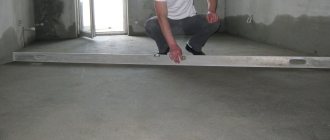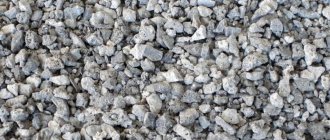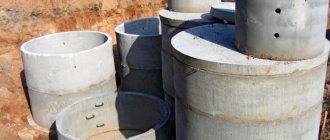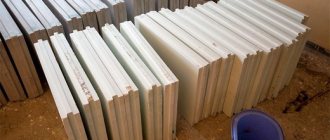Advantages of laying asphalt chips:
- Laying in small areas of up to 100 square meters can be done by just one person. This does not require any complex devices or equipment. A wheelbarrow or any suitable container is suitable for delivering material to the backfill site; you can level the coating with a shovel or rake. You can also compact asphalt chips using improvised means.
- Bituminous binder reliably holds individual particles together without any additional processing.
- The particles of such a coating are much lighter and softer than grains of crushed stone or gravel, so working with asphalt crumbs is much more convenient and easier.
- Asphalt crumb coatings can be laid in any weather, regardless of humidity, temperature of the source material and the base.
Road repair is a burning topic that affects absolutely everyone. Drivers complain about the lousy surface that ends up ruining their cars prematurely. Passengers of public transport - on the quality of transportation and schedule violations. Officials blame the lack of funding, which makes it impossible to carry out high-quality repair work.
You can spend a long time looking for the culprits or try to find an economical and effective solution to the problem. A step forward in resolving the current situation will be the use of recycled materials, namely the laying of asphalt chips.
Asphalt crumbs
Asphalt crumbs are a more than affordable product. This granulate contains small particles of asphalt and bitumen. It is the bitumen that, when heated and rolled, can provide good adhesion to the material.
It should be noted that laying a road surface from asphalt chips is a fairly simple task that does not require the use of special equipment.
— covering for small roads and sidewalks in the improvement of holiday villages and plots
— arrangement of temporary roads and passages
— elimination of road potholes
When planning to cover a road with asphalt chips, you choose from two laying options.
- Durable but more expensive technology
- digging a pit or leveling the ground (this depends on the landscape of the area)
- Geotextiles are laid on a pre-leveled surface.
- Geotextiles are covered with a layer of sand, then compacted
- The next layer is crushed stone
- Finishing layer – asphalt granulate
- Next, the last layer is rolled and compacted, and the road surface is ready.
- Budget technology
- First, the road surface is cleaned and leveled
- The leveled surface is filled with bitumen
- The first layer is asphalt granulate
- Bitumen is poured over the entire surface again
- The second layer is asphalt granulate
- The last layer is rolled and compacted
The use of asphalt chips is, of course, economically justified when constructing uncongested and temporary roads, for example in holiday villages. But before starting road work, it is necessary to accurately determine the required amount of materials.
If you plan to fill a layer 10 cm thick, then the required volume of granulate can be calculated as follows:
The area of the road that needs to be filled is multiplied by 0.2.
As a result, you will get the number of cubic meters that are needed to cover an area of 20 cm with a layer of crumbs. Further, when compacting the coating and distributing the material over uneven areas and holes, the layer will be compacted approximately twice and its thickness will become about 10 cm.
If the road is relatively flat, then the coefficient of 0.2 can be reduced to 0.15. And, if there are deep holes on the road, then you need to increase it to 0.3.
Price depends on:
- Fractions of granulate and its composition
- Order quantity
- Delivery addresses.
Do you want to know the total cost of asphalt chips that are needed specifically for your road?
Call us at 8(916)567-5152
We guarantee that we will quickly bring you asphalt chips in the required quantity at an affordable price.
The conversion factor is the number by which you need to multiply the price of 1 ton to find out how much 1 m3 of material costs.
| Name of material | Unit change | Weight | Conversion factor |
| Asphalt (asphalt concrete) | 1m3 | 2.3t | 2,3 |
| Asphalt granulate (black crushed stone) | 1m3 | 1.6-1.8t | 1,7 |
| Asphalt crumbs | 1m3 | 1.8-2.0t | 1,9 |
| Crushed stone | 1m3 | 1.4t | 1,4 |
| Sand | 1m3 | 1.5t-2.0t (average bulk: 1.55t) | 1,6 |
| Ready-mix concrete | 1m3 | 2.4t | Sold only in m3 |
| Sand-lime brick | 1m3 | 1.7t-1.9t | 1,8 |
| Loose soil (loam) | 1m3 loose soil | 1.69t | 1,69 |
| Soil loosening coefficient (loam) | 1m3 of dense soil | 1.42m3 loose soil | 1,42 |
What is asphalt crumb good for?
Roads at all levels are in dire straits - from federal highways, where resurfacing is necessary, to local roads. The latter often remain deprived of the attention of the authorities and over the years become completely unsuitable for traffic.
Recyclable materials obtained from recycling old asphalt are a universal resource for highway construction. The technology of laying asphalt chips allows you to solve a number of problems while spending a minimum of money. Crushed asphalt is suitable for both the construction of new modern roads and those with low traffic loads.
Reviews
Users rate the material positively. Reviews show that recyclable materials are suitable for designing passenger transport routes. Quotes taken from reputable construction forums.
Leonid: “Trucks left ruts on the crumb road, especially in the summer. The material is perfect for passenger cars - we filled it up 5 years ago until we observed any chipping or pushing through.”
Oksana: “We used it to design paths between the beds. There are no complaints - it doesn’t slip, doesn’t retain rainwater, doesn’t crack in the cold and looks neat.”
This is interesting: Styling curls for short hair 2020
Mikhail: “We thought about buying crushed stone, but crushed asphalt was almost 2 times cheaper - the highway was being repaired next to the site. It falls asleep and compacts easily; after 2 years there are no complaints.”
Asphalt crumbs are useful recyclable materials. The material is used in various industries and is suitable for landscape design. With its help, durable courtyard paths and public routes with low traffic flow are created.
Specifications
Crumbing is a simple process, and in operation it performs better than crushed stone. Such raw materials retain all their driving properties. Mechanical grinding of large layers does not affect the fact that the composition contains bitumen - a substance that is both astringent and creates additional density. This significantly extends the life of the road.
Another advantage of laying asphalt chips is that over time the quality of the road only improves: fragments of the old pavement are crushed and compressed so that a fairly smooth and durable coating is obtained. This makes asphalt chips a real panacea for villages, dacha cooperatives and other places where new roads will not be built in the foreseeable future.
Laying asphalt chips yourself
The undeniable advantage of this raw material is that you do not need special qualifications to work with it. The product of processing removed asphalt is becoming an increasingly popular material every day. The popularity of the raw material is also added by the fact that it has become possible to lay asphalt chips with your own hands.
If we are talking about a small area and there are no time restrictions, then even one person can cope with such a task. In the case of a large area, it is better to hire a team of workers.
Laying asphalt chips
It's no secret that the most practical, low-cost materials have always been used to repair road surfaces.
Even with the advent of new technologies and modern building materials, asphalt chips are the undisputed leader among construction companies. Its main advantages are ease of use, low cost, durability and protection against washout. Crushed asphalt is extracted from old asphalt pavement.
It is removed and crushed using a cutter. Then bitumen is added to the crushed asphalt, which holds the mass together and provides stronger adhesion to the road surface. The size of the crumb itself depends on the speed at which it is processed.
- It replaces crushed stone or sand.
- Excellent for finishing basement floors.
- on a summer cottage for finishing paths.
- Sometimes used as a decorative element by landscape designers.
- This material can be used to repair lightly trafficked roads.
This type of material does not require any special skills or abilities.
Working with it is extremely simple and understandable even for an inexperienced road worker. Another positive feature is the density of laying, which ensures the evenness and strength of the finished coating.
Before starting work, it is necessary to clear and prepare the work surface. After this, one layer is laid out with brick, then with concrete and crushed stone. All these layers must be carefully leveled and rolled using special equipment. Asphalt crumbs are placed on a flat, straight surface, which is also leveled over the entire area of the road surface.
Further along the entire perimeter there are road rollers.
They compact the layers of coating, making it durable and perfectly smooth.
After this, the road can be safely used. When working with asphalt crumbs, it is necessary to take into account some points necessary to ensure a high-quality road surface. The crumbs must be laid in two layers of 8-10 cm thick.
Moreover, the second layer is placed only after the first has been thoroughly compacted. If there are holes and irregularities, asphalt crumbs are used for filling to eliminate them. This is very economical and protects damaged areas of the road from being washed out.
- There are many videos on laying asphalt chips with your own hands on the Internet. After looking at some of them, you can easily cope with this task yourself.
- Outline and determine the perimeter where this type of repair work needs to be carried out.
- Buy the crumbs themselves, correctly calculating the required quantity (approximately 15 tons per 100 sq. m.).
- You need to find or rent a skating rink, you can use a manual miniature version.
- Remove the top layer of soil to a depth of 30 cm. It is necessary to make slopes for water drainage at the rate of approximately 5-7 mm per meter.
- Place borders along the edge.
- Spread and even out the crumb layer.
- It is necessary to compact the surface using a roller. The surface is rolled until the coating is completely hard.
- If desired, you can cover the whole thing with bitumen solution on top. This will add additional strength and significantly increase service life.
We recommend reading: Online complaint regarding catering issues Moscow
Before starting work on summer cottages and household plots, it is necessary to take into account the location of all communications, trees, and outbuildings. It is advisable to ensure the presence of one or more assistants or auxiliary workers.
Of course, you can do it alone, but it will take much more time and effort. at the dacha - this is not necessarily reconstruction or the creation of paths, it can be a skillful, amazingly beautiful landscape design with her participation. Chips are often used as a decorative element by landscape designers because of their color.
You can also use crushed asphalt for your basement floor. Whatever option you choose and whatever method of application you find, it is always an acceptable price in exchange for excellent quality and durability!
Work order
So, you don’t need a builder’s qualifications to lay asphalt chips. All you need to know before starting work is calculating the material. Taking into account the terrain, the consumption of raw materials will be approximately 15 tons per 100 square meters. m. You need to rent a roller weighing 10-14 tons from a company that supplies asphalt crumbs.
The preparatory activities required for laying asphalt chips include removing bushes and grass and leveling the road topography. If possible, it is better to cover the prepared, flat surface with bitumen mastic. This way you will secure the material and prevent the crumbs from scattering at first, until they are compressed under the constant pressure of the wheels.
The technology for laying asphalt chips with your own hands is not complicated: the work is carried out in 2 stages, pouring each layer of raw material and pressing it with a roller. One layer should be approximately 10 cm thick. After final compaction, the road is ready for use.
Working with asphalt crumbs is easy. Compared to other loose coatings, it wins because over time it becomes stronger and holds better, while sand and crushed stone scatter along the roadsides. In addition, the advantage of recyclable materials is its low cost. Although it doesn't perform as well as new asphalt, it is a real lifesaver for roads that have been starved of funding for years.
Thus, in the case of building roads from asphalt crumbs, a very dense and strong surface is formed, which is subsequently rolled by car wheels, becomes harder, and does not collapse or erode.
One of the most common recycled materials obtained through recycling is asphalt chips, also known as asphalt granulate, which is used in a wide range of construction and renovation applications.
This material is obtained by crushing old asphalt pavement, removed during replacement or repair of the roadway, using cold milling. Thus, asphalt chips consist of particles of bitumen and small crushed stone from three to five millimeters in diameter, and may also contain traces of sand or other elements.
Laying asphalt chips
It’s worth saying right away that you won’t be able to lay asphalt chips alone; it’s better to get two or three assistants. The laying process itself is incredibly simple:
- Scatter the crumbs around the perimeter and level it.
- As we go, we compact the surface with a roller until it hardens completely. By the way, the skating rink is quite easy to operate, so no special skills are required.
- If desired, you can fill the asphalt crumbs with a special bitumen emulsion.
Now the laid path is completely ready for use.
You can see how asphalt chips are compacted in this video:
One of the most common recycled materials obtained through recycling is asphalt chips, also known as asphalt granulate, which is used in a wide range of construction and renovation applications.
This material is obtained by crushing old asphalt pavement, removed during replacement or repair of the roadway, using cold milling. Thus, asphalt chips consist of particles of bitumen and small crushed stone from three to five millimeters in diameter, and may also contain traces of sand or other elements.
Using asphalt chips
Due to its inexpensive price, ease of operation, and the fact that crumbs, as a processed product, cause relatively less harm to the environment, the range of its applications is extremely wide and includes almost all areas of human economic activity:
Due to the widespread use of this material, as well as the presence of many other options on the market, consumers, trying to find the most suitable option for themselves, often ask the question of how much a cube of asphalt chips costs. Below, in abstract form, are the main reference characteristics of this material, including answers to questions such as how much 1 cube of asphalt chips weighs and how many cubes fit in a KAMAZ or dump truck.
- The average price of asphalt chips in Moscow is $12-14, in the regions it starts from $10;
- 1 cube of asphalt crumbs can weigh from 1500 to 1900 kilograms, depending on its composition;
- Accordingly, about 12 cubic meters will fit into the body of an average KAMAZ;
The consumption of crumbs per m2 with a layer thickness of 20 centimeters is approximately 400-600 kilograms.
Composition and properties
Asphalt or asphalt crumb consists of crushed asphalt, bitumen resin residues and crushed stone (fraction 0-40). Which in its composition resembles ordinary asphalt with a modified structure. After the period of operation of the road surface, the quality indicators of asphalt crumbs are lower than those of asphalt. This, in turn, makes it possible to obtain cheap material for laying road surfaces.
The properties of properly laid asphalt chips make it possible to obtain a Category III road that allows you to establish communications in the periphery, in gardening communities, etc.
Laying technology
- First of all, prepare the base for the asphalt chips. The area is leveled, large debris is removed: cobblestones and scrap metal. It is quite possible to skip this point if the terrain conditions are acceptable for this purpose.
- Variably, the surface is primed using a bitumen emulsion of asphalt chips for better adhesion in the future. Its consumption is about one liter per sq.m.;
- Laying crumbs on the surface, compacting the laid layer. This can be done either with specialized equipment or independently. It is worth remembering that the compaction coefficient of asphalt crumbs, depending on the composition, reaches a value of 2 units, which means that when rolling, the thickness can be reduced by up to two times and be sure to include this factor in the calculations!
- Impregnation of bitumen emulsion of asphalt crumbs. This will further strengthen it and increase its service life. Consumption is about 0.5 liters per m2.
Laying asphalt chips with your own hands is not too different from the technology described above. The only difference is that you will have to lay it out yourself using shovels, and roll it away with cars. Difficulties may arise with how to melt asphalt crumbs: without the use of technology, this is not only labor-intensive, but also flammable. You can melt the crumbs over an open fire in a metal container of sufficient size. Be sure to have a fire extinguisher with you to put out a possible fire!
Application of asphalt crumbs
If compaction of the crumbs is carried out not by a roller, but by a vibrating plate or machine wheels, then the coefficient will be 1.5.
I took half a kilo of mastic into the kettle and heated it. poured it on, tamped it down, and let it cool. It sticks even at +15 to +30, it will generally be chwack-chwack. I closed the jar and returned it))) 09/14/2015, 10:00 09/14/2015, 09:44 road workers limit travel for a day After flashing this.
You can also find out how much asphalt chips are needed in this case using the formula - it turns out that for backfilling 200 sq. meters of a road or site will require 30 m3. As a rule, the density of asphalt crumbs depends on the fraction - it can be small, medium and large. Therefore, depending on the composition of the material, 1 cubic meter of asphalt granulate can weigh 1500-1900 kg.
And if you need to purchase KAMAZ asphalt crumbs, then approximately 12 cubic meters will fit in the car. And, finally, about the cost of asphalt crumbs.
The total price of the material depends on the fraction, composition, and the presence or absence of additional additives to achieve coating strength.
Pros and cons of using asphalt chips
First, let's mention the environmental aspect of using asphalt chips. Many people, among those who will beautify their summer cottage and have children and animals in the family, are interested in whether asphalt crumbs are harmful. Despite the fact that it contains bitumen - a product of oil refining, which accordingly causes more harm to the environment than good, the use of crumbs on the farm is more environmentally friendly than in the case of asphalt of the same volumes.
According to the documentation, asphalt crumbs have a hazard class of 4, on a par with household waste such as old clothes and shoes.
- Wide range of applications, covering most areas of human economic activity;
- Affordable price, which makes asphalt crumbs stand out against the background of crushed stone or gravel and, due to similar properties, has recommended the crumbs as a suitable replacement for them;
- Long service life when used in suitable conditions: secondary roads and short paths and sports complexes;
- Easy to install. To do this, it is not necessary to prepare the surface in advance, and rolling asphalt chips does not necessarily require the participation of special equipment; in order to save money, it can be done with the help of passing cars;
- High resistance to adverse weather conditions.
Disadvantages of asphalt chips, like any other material, exist:
- More harmful impact on the environment compared to crushed stone or sand;
- The need for periodic renewal of the canvas.
However, all the shortcomings are completely offset by its numerous positive qualities.
Alternative options
In addition, consumers often ask the question: which is better, asphalt chips or crushed stone? There is no definite answer to this, since these materials, including sand and broken brick and concrete, as a rule, perform the same functions. But the price of crumbs is lower, and crushed stone has a less harmful effect due to the absence of bitumen. So you need to make a choice based on circumstances and personal preferences.
Let's sum it up
Thus, asphalt chips will be an ideal option for you if you value simplicity and ease of installation and prefer to spend extra money on yourself and your loved ones rather than on building materials. For a parking lot or driveway, sports field or garage floor - this material will satisfy any of your needs!
A simple and affordable way to arrange playgrounds and paths near your house with your own hands is to lay asphalt chips obtained by recycling old asphalt pavement after its layer-by-layer cutting and crushing. This secondary material, unlike paving slabs, does not require preliminary calculations and complex installation measures, and provides high density and uniformity of the coating due to the bitumen contained in the mixture. Often used for pothole repair of ordinary roads.
To cover 100 m2 you will need approximately 10 tons of material and a roller - manual or conventional. This consumption rate is sufficient to improve the area near the house. The created layer is 40 mm. Its service life is 7-10 years.
Work order
- Marking the site, removing 15-25 cm of soil while maintaining a slight slope for drainage of melt and rainwater.
- It is recommended to cover the bottom with geotextiles.
- Installation of borders and posts.
- Laying a layer of sand with a tamper, and then crushed stone, also with a tamper. For the home site, a 15 mm thick crushed stone layer is sufficient. The grain size of the material is 20-40 mm. In areas with high groundwater, larger fractions are used - 70-140 mm. They act as drainage.
How to determine the quality of crumbs
It depends on many factors, but the main ones are the source of raw materials and the production method. The source of raw materials are roads that are being repaired. Better coverage is on the main roads, that is, the crumbs from there are better.
As for the production method, there are two of them: using a cutter and using a stationary crusher. Milling production is carried out on site, immediately after the asphalt is removed. The milling cutter crushes the asphalt, and the finished product is immediately sent for shipment. This crumb is of higher quality, but it is produced only during road repairs.
With the help of a crusher, crumb production is carried out all year round, but its quality can vary - it depends on the quality of the raw materials and the size of the resulting fractions. But the cost of the material is cheaper.
A simple and affordable way to arrange playgrounds and paths near your house with your own hands is to lay asphalt chips obtained by recycling old asphalt pavement after its layer-by-layer cutting and crushing. This secondary material, unlike paving slabs, does not require preliminary calculations and complex installation measures, and provides high density and uniformity of the coating due to the bitumen contained in the mixture. Often used for pothole repair of ordinary roads.
To cover 100 m2 you will need approximately 10 tons of material and a roller - manual or conventional. This consumption rate is sufficient to improve the area near the house. The created layer is 40 mm. Its service life is 7-10 years.
Work order
- Marking the site, removing 15-25 cm of soil while maintaining a slight slope for drainage of melt and rainwater.
- It is recommended to cover the bottom with geotextiles.
- Installation of borders and posts.
- Laying a layer of sand with a tamper, and then crushed stone, also with a tamper. For the home site, a 15 mm thick crushed stone layer is sufficient. The grain size of the material is 20-40 mm. In areas with high groundwater, larger fractions are used - 70-140 mm. They act as drainage.
Self-laying asphalt chips near the house
The simplest and most affordable method of arranging beautiful paths and parking near the house is asphalting. It uses asphalt chips. Its installation does not require precisely calibrated calculations and lengthy installation, unlike concrete slabs and paving slabs. Even if you are new to construction, laying asphalt near your house will not be difficult. Let's consider the algorithm of actions preceding this operation, as well as the asphalt paving procedure itself.
Work begins with digging a pit. Its depth should take into account all elements: sand cushion, crushed stone and asphalt itself. The end result should be in line with the rest of the area. It is advisable to compact the bottom of the path base with a vibrating plate.
Pour the required amount of crushed stone onto the bottom in an even layer and level it. For a home plot, a layer of 15 cm with a fraction with a diameter of 2-4 cm is sufficient. Larger fractions of 7-20 cm will be required if groundwater comes close to the surface. In this case, the crushed stone will serve as drainage. Do not forget to compact the crushed stone with special vibrating machines and rollers up to 6 times. It is at this stage that slopes are created (0.5 cm per meter of track) where rainwater will flow. Also at this stage decorative elements are laid: fences, posts, curbs, hatches.
The final step is laying the asphalt. They lay it at the rate of 1 ton per 10 square meters. This is enough for pedestrian paths and parking lots near the house with a thickness of 4 cm. Special machines and vibrating plates are used for compaction. If you plan to lay several layers, then bitumen is applied between them for adhesion. Periodically, the laid asphalt is watered with water for better compaction. Correctly completed stages of work will ensure impeccable service of the asphalt pavement for 7-10 years.
Composition of asphalt crumbs
The main components of the material are gravel, crushed stone, sand and bitumen. Concrete may also be present as a binder. The ratio of components depends on the brand of asphalt, the type and condition of the road surface during removal. On average, a crumb includes:
The concentration of the latter in crumbs is less than in asphalt - the binding component leaves the coating during the operation of the road, creating the need for its repair.
Specifications
The product is a crushed road surface. It is carried out at the repair site - asphalt paving equipment includes equipment that crushes the road surface. Grinding is carried out after removal. Pieces of asphalt are sent to granulate into crushers.
The result is crumbs 3–5 mm in size, differing, depending on the production method, in the following parameters:
The crumbs may include different types of asphalt - this affects the weight and other characteristics of the product. So, the mass is 1 cubic. m of crushed pavement varies between 1.5–2.0 tons. The heaviest is asphalt concrete; mixtures without cement have less weight due to the absence of fine fractions.
Asphalt crumbs: production and features
Asphalt crumbs are obtained by recycling old road surfaces. It is made in two ways:
- Remove worn road surfaces using a cold planer. Grind to granules 3–5 mm in size and immediately use for laying a new coating. Bitumen is added if necessary.
This is how a cold planer removes road surfaces
- The removed road surface is crushed into large fragments. For this purpose, roller crushers or asphalt granulators are used. After crushing, the material is sorted into fractions and reused. The asphalt crumbs obtained in this way are larger in size and less water resistant, but are cheaper than those obtained using the first method.
When laid, asphalt chips form a looser structure than a new road surface, but due to bitumen it is capable of forming a monolithic layer that can withstand mechanical loads.
Recycled materials are optimal for building roads with low loads
What is asphalt crumb good for?
The material is used by industrial enterprises and individuals. Recyclable materials are included in new asphalt mixtures. Depending on the type of product (cold or hot), the waste coefficient in the new material is 0.25–0.6. That is, the share of crumbs reaches 25–60%.
The material is also used for the following works:
- local repairs - the crumb will reduce the consumption of primary asphalt when filling holes;
- preparing the base of the route;
- covering secondary and country roads with low traffic levels;
- strengthening artificial terrain - recyclable materials can be used to fill the shafts of railway and highway tracks;
- improvement of household and public areas - laying of asphalt crumbs is carried out in parking lots, country roads, sports fields and floors of technical premises.
To work with recyclable materials, you will need equipment capable of compacting and melting the bitumen into the mixture. The last procedure is not necessary - you can lay the crumbs without heat treatment - the binder will bind the particles together during the compaction process.
Technology for laying asphalt chips
The application process depends on the area of application - when strengthening the relief, the mixture is scattered in an even layer (at least 20–30 mm) and leveled with a roller tool. In the case of laying paths, the site is first marked, and soil is excavated inside the contour of the future roadbed. Crumbs are poured into the recess and then compacted. The principle remains the same when creating secondary highways and landscaping the yard.
How to lay asphalt chips with your own hands
First of all, the required volume of raw materials is calculated.
Paths made of asphalt chips in the country will require a depth of 30–40 mm. With a width of 50 cm per 100 m of coverage, you will need 0.15 cubic meters. m of material. Or 0.23–0.3 tons of product, depending on density.
With a Kamaz carrying capacity of 6 tons, one vehicle is enough (almost 2 kilometers worth of raw materials) to mark routes in the yard and fill holes behind the gates.
- Marking - a diagram of paths is drawn, which is transferred to the territory of the site.
- Preparing the site - 30-40 mm recesses are dug in the marked contours - the basis of future paths; boards or a concrete window sill can be placed at the bottom of straight sections to strengthen the structure in loose soil. Instead, geotextile bedding can be used.
- Filling the crumbs. If you plan to melt bitumen, you will need a tin barrel and thick gloves. A rake can be used for leveling.
- Tamping. For large jobs, such as priming the road in front of a private house, a miniature skating rink is rented. Decorative and narrow paths inside the yard are compacted manually with a roller tool. Wait at least 24 hours for the material to cool or set before using a new route.
Laying asphalt chips with your own hands is easy. The presented algorithm is also suitable for improving technical premises: a barn or a garage. When creating the basis of a parking space, the weight of the vehicle is taken into account. A parquet SUV will require a thicker floor compared to a passenger model.
How long will an asphalt road last?
So what is hidden behind the concept of “road service life”? In simple words, we mean by this a period of time during which the bearing capacity of the road decreases to the maximum permissible level of deformation. That is, this is the period of operation of the road until the moment when repairs are necessary.
What determines the duration of this period? Of course, the service life of the road is significantly influenced by climatic conditions and the intensity of traffic flow. But the main thing to remember when building a road is that the service life of the roadway directly depends on the accuracy of the installation technology and the quality of the materials used.
Asphalt crumbs are classified as temporary coating options and their service life is approximately 3-5 years. But if all the requirements of building codes are taken into account when constructing a road, and if you successfully select high-quality building materials, then the road can last much longer without repair. In addition, repairing such a road is relatively simple (as is its construction).
Using asphalt chips in the construction of roads with low loads (country roads, temporary roads, access roads), you can get a high-quality road surface with high strength indicators and a long service life at a reasonable price!
A sports ground, a park path, a parking space, and a road in a holiday village - all this can be built using asphalt chips. This popular building material, not much inferior to asphalt (after all, crumbs are a derivative of asphalt), is much lower in price, and the technology for its installation is simple and accessible even to a “private owner” who is far from construction.
Asphalt granulate is successfully used in the construction of roads with low traffic loads due to its obvious advantages:
Low price. Asphalt crumbs are obtained by layer-by-layer removal of worn-out road surfaces during road repair and reconstruction. This is a recycled building material, and therefore much cheaper than asphalt itself.
Moisture resistance. The high moisture resistance of asphalt granulate is explained by the presence of bitumen mixtures in its composition and the low water permeability of crushed stone. Such a road will not become soggy from heavy autumn rains and will withstand the test of February snowfalls with honor.
Strength. Asphalt crumbs contain quite a lot of crushed stone, which has high strength properties. In addition, asphalt chips are easily compacted, and this ensures the necessary density of the road surface.
Adhesiveness. Like any type of asphalt, crumb has excellent adhesion due to the bitumen mixtures included in its composition.
Life time. If the technology is followed during the laying of the road surface and the quality of the crumbs is high, such a road has a significant service life.
So what is hidden behind the concept of “road service life”? In simple words, we mean by this a period of time during which the bearing capacity of the road decreases to the maximum level. That is, this is the period of operation of the road until the moment when repairs are necessary.
What determines the duration of this period? Of course, the service life of the road is significantly influenced by climatic conditions and the intensity of traffic flow. But the main thing to remember when building a road is that the service life of the roadway directly depends on the accuracy of the installation technology and the quality of the materials used.
Asphalt crumbs are classified as temporary coating options and their service life is approximately 3-5 years. But if all the requirements of building codes are taken into account when constructing a road, and if you successfully select high-quality building materials, then the road can last much longer without repair. In addition, repairing such a road is relatively simple (as is its construction).
Using asphalt chips in the construction of roads with low loads (country roads, temporary roads, access roads), you can get a high-quality road surface with high strength indicators and a long service life at a reasonable price!
Useful information about sand
- Where is washed sand used?
- Where is quarry sand used?
- Where is river sand used?
- Where is seeded sand used?
- What is sand filtration coefficient?
- How much does sand weigh?
Useful information about crushed stone
- Where is crushed gravel used?
- Where is granite crushed stone used?
- Where is crushed limestone used?
- Where is gravel used?
- Main characteristics of crushed stone
- What is decluttering?
Important and useful information about asphalt crumbs
- What types of asphalt chips are there?
- What is ShMA crumb?
- How to properly lay asphalt chips?
- How to calculate the required volume of crumbs?
- When is the best time to buy asphalt chips?
- How long will an asphalt road last?











